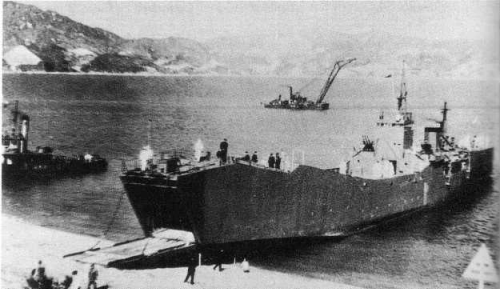

149-go 1944

149-go 1944
| Name | No | Yard No | Builder | Laid down | Launched | Comp | Fate |
| 第101号輸送艦 [101-go] | Osaka Zosen | 12/1943 | 25.1.1944 | 3.1944 | sunk 28.10.1944 | ||
| 第102号輸送艦 [102-go] | Osaka Zosen | 12/1943 | 5.2.1944 | 3.1944 | sunk 26.10.1944 | ||
| 第127号輸送艦 [127-go] | Kawanami Kogyo | 10/1943 | 13.1.1944 | 2.1944 | sunk 24.9.1944 | ||
| 第128号輸送艦 [128-go] | Kawanami Kogyo | 11/1943 | 10.2.1944 | 3.1944 | sunk 4.6.1944 | ||
| 第149号輸送艦 [149-go] | Hitachi, Mukajima | 11/1943 | 25.12.1943 | 2.1944 | damaged 12.1.1945, repaired as passenger ferry | ||
| 第150号輸送艦 [150-go] | Hitachi, Mukajima | 12/1943 | 27.1.1944 | 3.1944 | sunk 27.7.1944 |
|
Displacement standard, t |
950 |
|
Displacement normal, t |
1010 |
|
Length, m |
72.0 pp 75.0 wl 80.5 oa |
|
Breadth, m |
9.10 |
|
Draught, m |
2.89 |
|
No of shafts |
3 |
|
Machinery |
3 diesels |
|
Power, h. p. |
1200 |
|
Max speed, kts |
13.5 |
|
Fuel, t |
diesel oil |
| Endurance, nm(kts) | 3000(13.5) |
|
Armament |
1 x 1 - 76/40 11-shiki, 2 x 3 - 25/60 96-shiki |
| Military load | 14 7t tanks or 9 15t tanks or 7 2-shiki amphibious tanks or 218t of cargo or 320 marines or 120 marines and 67t of cargo |
|
Complement |
90 |
Project history: Design of SB class landing ships was prepared in the second half of 1943. On request of Naval Staff they should were to exceed the ships of SS class, insufficiently fast for carrying out of operations in the conditions of domination of the air enemy.
New landing ships were very similar to USN contemporaries of LST(2) type, but were smaller and faster. There were prepared two variants of the design, differing by machinery: SBD class ships had 3-shafts diesels, and SBT single-shaft turbine. Latter ensured higher on 2.5kts speed, but diesel ships had increased capacity of cargo holds. In remaining diesel and turbine variants resembled each other, and outwardly they could be distinguished under the funnel form: on SBD it was more low and more widely, while on SBT it was higher, wider and more close to a superstructure. Beaching was effected through a folding bow ramp. For raise of a hull strength keel at fore end was fulfilled doubled, however operating experience of first ships has demanded carrying out of hull reinforcement.
They were built under the 1943 program. At all six ships of SBD class were completed, orders for 27 SBD were cancelled in late 1944 - early 1945. Building of Ò164 and Ò165 was suspended in May, and Ò175, Ò176, SB127 and SB128 in August, 1945.
Modernizations: 5.1944, all completed: + 2 x 1 - 25/60 96-shiki, 1 DCT (12)
9/1944, all completed and survived: + 2 x 3 - 25/60 96-shiki, 7 x 1 - 25/60 96-shiki
Naval service: Ò128 (sunk 4.6.1944 by US aircraft NE off Morotai), Ò150 (sunk 27.7.1944 by US carrier aircraft near Palau), Ò127 (sunk 24.9.1944 by US carrier aircraft near Manila), Ò102 (sunk 26.10.1944 by US carrier aircraft in Guimaras Straits) and Ò101 (sunk 28.10.1944 by US aircraft in Ormock Bay) were lost. T149 was badly damaged 12.1.1945 by US carrier aircraft near Cape St. Jacques and repaired as passenger ferry Kuroshio No2 (surrendered in August, 1945).

149-go 3.1944
© Ivan Gogin, 2008-14